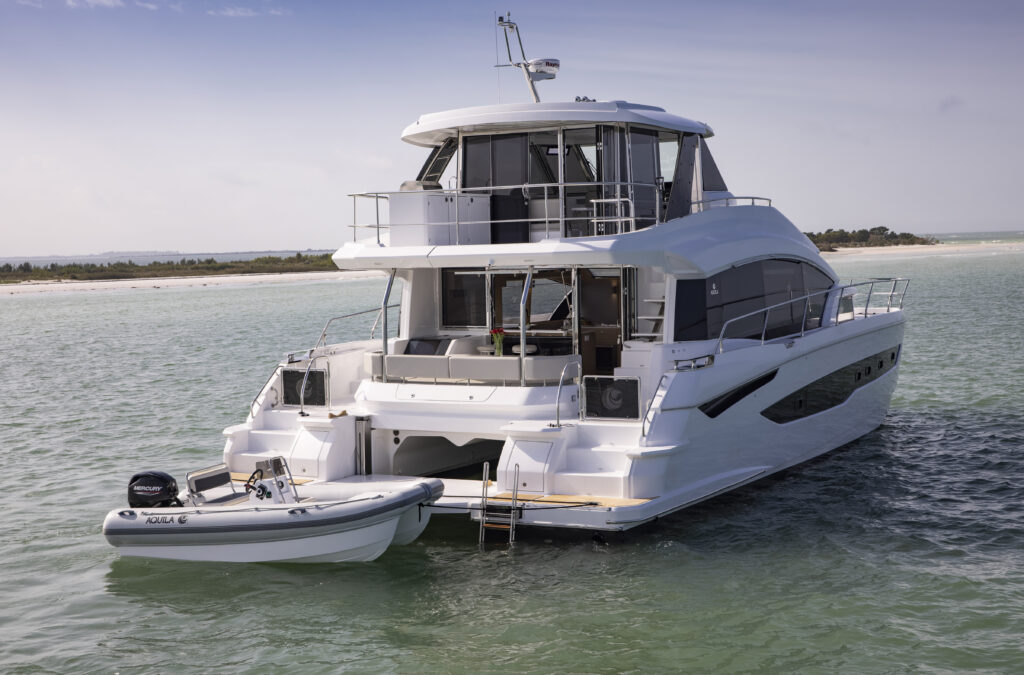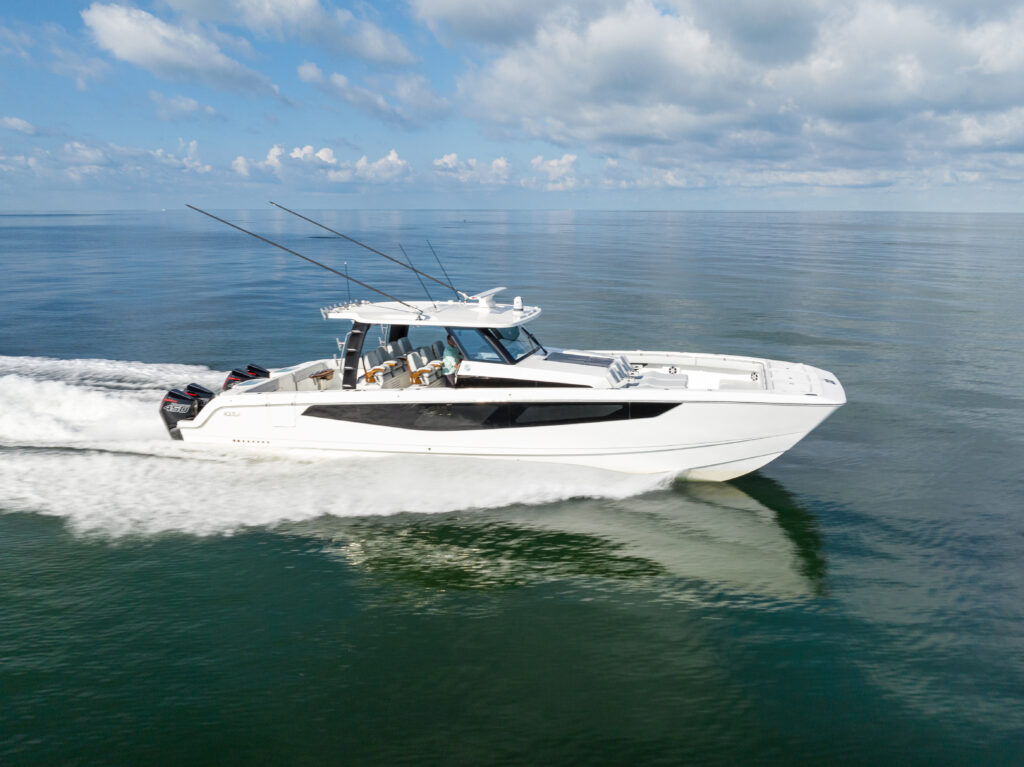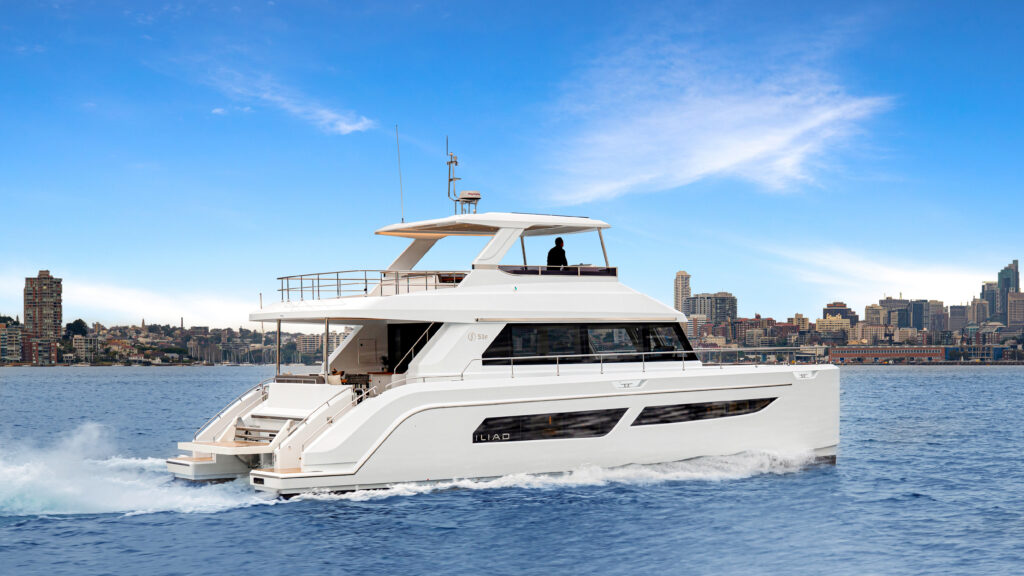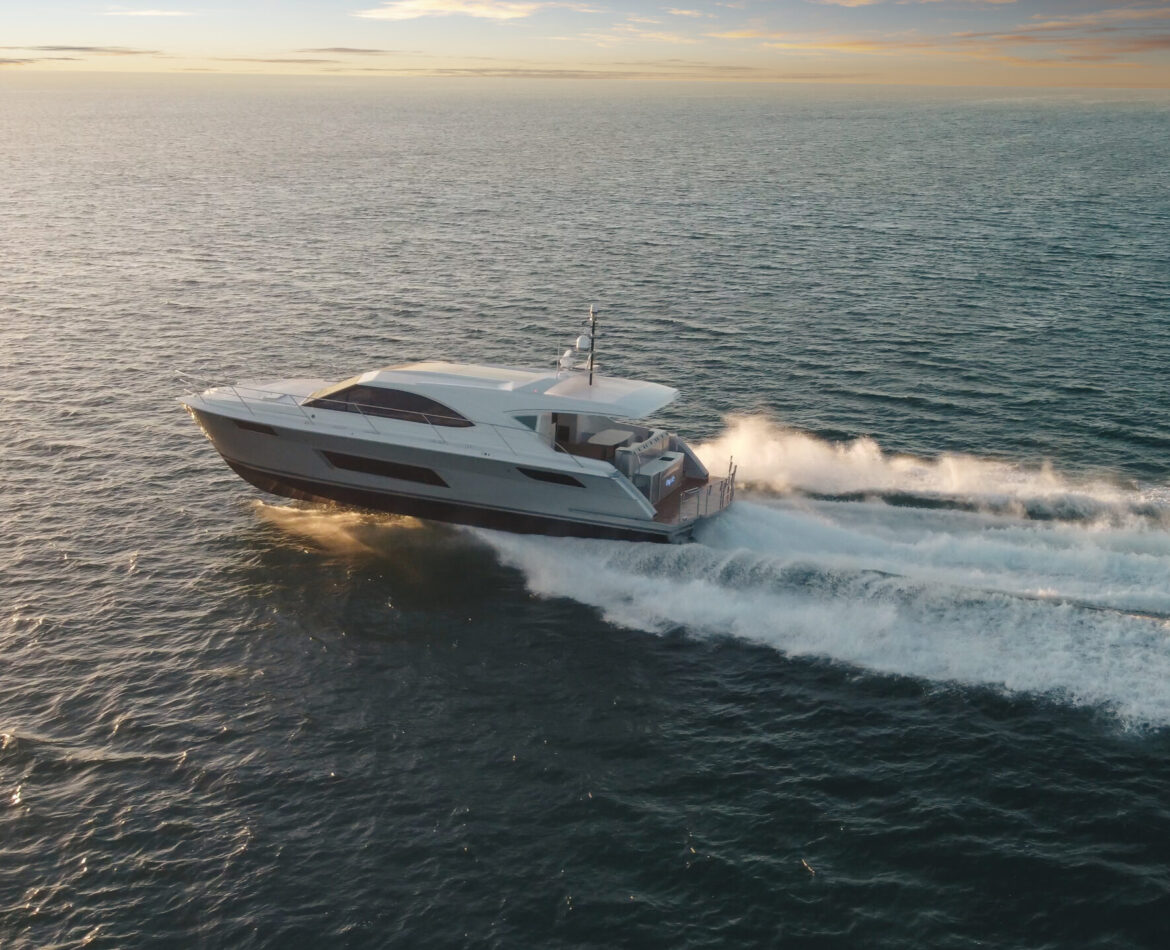As power catamarans thrive as one of the fastest growing sectors in the boating market, it’s timely to consider the variations of power catamarans, their hull types, performance capabilities and the features they offer new owners in their boating lifestyle.
Power catamarans, once considered a niche within the boating world, are steadily comprising a bigger slice of the market. They offer a wide range of options in performance, comfort and interior & exterior layouts. From sleek planing vessels to efficient displacement hulls, the power catamaran market delivers a large variety of designs to meet the needs of a wide variety of cruisers in New Zealand and Australia. Brands around the world specialise in producing hundreds of production power cats every year including Fountaine Pajot, Iliad and Aquila. As we featured in a company profile last year, the Aquila brand for example offers eight power catamaran models in three categories from 9.38m to 21.26m.

Ranging from 10m to more than 30m, power catamarans from overseas and local designers can be configured for applications from coastal cruising to adventurous longrange voyages. With that in mind, it’s helpful to identify your goals and the attributes that will best help you achieve them in regards to comfort, cruising times, fuel budget, and even the relationships of those onboard – a family with children, teenagers or grandchildren; several couples; a skipper and deckie with charterers; bare boat charterers; a group of young surfers or retirees on their swansong – all will have different preferences in cooking styles, accommodation, watersports, time constraints, sleeping options, and preferences in the boat’s motion at anchor and at sea. With local and overseas designers and builders contributing to the expanding power catamaran market, there are plenty of options.
In the mid 1970s powerboat designers started creating boats in which the galley was ‘up’ not ‘down’. They drew windows larger to create light, spacious-feeling interiors. Ventilation improved and equipment such as marine hot water systems, electric toilets, marine refrigeration and gas stoves became available at more realistic prices. However, accommodation was still a limiting factor. Only the bigger boats had choices with spacious cabins. For the smaller boats, with narrow hulls compared to modern boats, sleeping accommodation was more like camping or caravanning, with little privacy and don’t even think about ensuites. Crews tended to be groups of guys or one family per boat. But while onboard comfort was improving rapidly with modern developments, for some there was still a major factor in whether or not they would go boating: the powerboat’s motion and its effects on sensitive stomachs, particularly at anchor.

Stability on power catamarans
For many, stability is a major attraction of the power catamaran and most power catamaran owners will proudly have a bowl of fruit on the saloon table, just because they can. In particular, the beamy non-planing power catamarans demonstrated greater stability underway and at anchor.
Increased deck space
The power cat’s generous beam creates expansive deck space and interior volume, especially because this generous beam extends forward almost to the bow and aft to the stern. This consistency of beam creates a lot of deck space in terms of area and usable space. Imagine viewing a cruising power catamaran from above – it is almost rectangle in shape, with just a small taper going forward.
Large internal volume and accommodation
The interior volume of the power catamaran and its twin hulls provides plenty of options for private cabins. Often there is a cabin in each corner; ie. for’ard and aft in the port and starboard hulls. This option is ideal for the bareboat charter market where privacy is important as the charter cost is often shared between four couples on holiday. This also works well for multi-generational family groups with kids taking one corner and adults the other. In shared boat ownership, a cabin or entire hull can be locked off when one of the owners is not on board. A 12m power cat with a flybridge can have four sleeping cabins with two shared ensuite bathrooms and a 13-14m power cat could have four cabins with ensuites if desired. Modern boaters love interior volume, which is why most production boats, monohulls and multihulls, have plumb stems, and wide and high-sided hulls to provide large cabins. These features are not always advantageous offshore, but when comparing boats at the marina or boat shows, interior volume can be a big factor in making a sale. The wider individual hulls of these planing coastal cruising power cats provide large floor space for bunks and bathrooms, and higher static stability than narrower, more fuel-efficient hull designs.

Going cruising
In New Zealand, unless you leave the country, all cruising is coastal and the distances between refuelling facilities are relatively short, therefore the planing type power catamaran will be acceptable as it will have the range at sprint speed to make ports and avoid the type of conditions for which it is less suited. With Australia’s extensive coastline, these planing type boats generally need to cruise at displacement speed to get the range required between refuelling facilities. For this reason, they need to plan their trip carefully around weather patterns to minimise the risk of being caught out at sea, as they do not have the range at high speed to outrun them. We therefore see a greater and more consistent demand for the long range cruising power cats in Australia, which leads us to the characteristics of different hull forms. This is not to say that production planing power catamarans cannot undertake longer passages; it just means they will have to do so at displacement speed. Likewise a power catamaran designed and optimised for long range offshore cruising will still make an excellent coastal cruiser, however it will generally have less internal volume for accommodation.
The hull story
At the heart of every power catamaran lies its hull form, which dictates its performance characteristics. There are three primary hull types: displacement, semi-displacement and planing. Each type addresses different priorities, from fuel efficiency to speed and stability.
Planing Powercats – the need for speed
Planing power cats are designed for exhilarating performance, featuring medium to high deadrise hulls that skim across the water’s surface. These vessels prioritise speed, utilising hard chines to reduce wave drag and achieve impressive speeds. Notable examples include Pachoud Yachts’ Voodoo foil-assisted power cats, renowned for their high-speed capabilities and sleek design. Planing powercats can and do successfully undertake ocean passages; for example, the trans-Tasman crossings of the Roger Hill-designed, 17.5m Voodoo which covered the 1229nm in 53.5hrs @ 23 knots average in 2023. Semi-Displacement Cats – balancing speed and comfort Semi-displacement power cats offer a blend of speed and comfort, making them ideal for leisurely cruising and extended voyages. With their good sea-keeping abilities and moderate speeds, these vessels prioritize fuel economy and spacious interiors. Models like Fusion Marine’s Prowler 10.8 and Fountaine Pajot’s Cumberland 47 exemplify this balance, providing comfortable accommodation and efficient performance for cruising. Later in 2024, we anticipate the launch of two de May Spaceship 18m semi displacement power cats, both semi bespoke custom builds, from the drawing board of Roger Hill Yacht Design, built by Nic de May Yachts using hi-tech materials and systems. (Check an issue of Powerboat magazine later this year for the full review).

Displacement Cats – prioritising stability and economy
Displacement power cats prioritize stability and fuel efficiency over speed, offering a steady and economical cruising experience. Designed with long, narrow and easily-driven hulls, these vessels excel in seaworthiness and comfort. Notable examples include the Horizon PC60 and the Peter Bradydesigned Rehab, renowned for their economic performance and excellent sea-keeping capabilities. As with any displacement boat, it pays to experiment with different speeds in different conditions to find what is most comfortable on the day. It’s possible for displacement cats, provided they are long enough, to run upwards of 25 knots with standard underwater running gear. The late Kiwi designer Malcolm Tennant enjoyed considerable success over the years, especially with his displacement catamarans. His approach was the ‘long and thin’ style of easily driven, round bilge, minimum wetted surface hulls that gave great performance and sea keeping capability with excellent fuel economy.
OTHER TYPES OF POWER CATAMARANS ON THE MARKET
The Sports Fishing Power Catamaran
With its shorter coast line, the New Zealand sports fishing cats are more likely to be of the planing hull type, whereas in Australia where long range is more important, they are often displacement hulls. Either of these hull shapes make an excellent sports fishing boat for their stability at rest and narrow transoms which allow them to back down fast if required. They differ from the volume type of power cat in their aft decks or cockpits which are designed around fishing rather than sun bathing. Expect to see multiple rod holders, bait boards, kill tanks, live bait tanks, ice makers and usually generous refrigeration to handle the beer and the fish.
The high speed foil assisted power catamaran
This type is a relatively new development; it is a small market on the cutting edge of technology and materials. Because of the need to keep the hull bottom and particularly the foils clean and smooth, these boats will need to be well looked after to perform as designed. Their foils may be vulnerable to debris damage which may restrict their operating areas. They have proven that, with the right weather window, they can make ocean passages.
Long-range offshore cruising versus coastal cruising
In comparing power catamarans for different types of cruising, consider these qualities for a long-range offshore power catamaran:-
- Generally narrower, more fuel efficient hulls for a high cruising speed over long distances;
- Raked bows for a softer, drier ride;
- Large fuel capacity and usually old school, mechanically-injected diesel engines that are more tolerant to low-quality fuel – sometimes a concern at remote, foreign ports;
- Large engine rooms with, preferably, internal access so that deck hatches do not need to be opened in rough conditions to check the engines.

The attraction of power catamarans
For many boaters, stability and comfort are paramount when choosing a vessel. Power catamarans, with their wider beam and dual-hull configuration offer good stability, which is a factor in reducing seasickness, and a manageable platform for passengers of all ages. For this reason some power monohulls are available with stabilsers and fins which enhance stability underway and at anchor. Of course, some people prefer the motion of monohulls and the ability to steady yourself from hand-hold to hand-hold in rough conditions, whereas there are often wide spaces between hand holds on the power catamaran.
When floor space is important, the spacious layout of power catamarans allows for versatile interior configurations. From expansive saloons to private cabins and outdoor entertainment areas, these vessels offer ample space for relaxation and socializing, above and below deck. The performance of a power catamaran reflects its power-to-weight ratio and hull design. While planing vessels prioritise horsepower for high-speed planing, displacement cats rely on hull shape for efficient cruising. Understanding these dynamics helps boaters choose the optimal power configuration for their vessel, balancing performance with fuel efficiency. It is a matter of considering hull length, displacement, power requirements, accommodation, comfort and speed when selecting the most suitable boat for your requirements.



